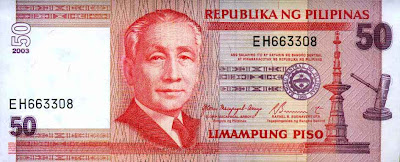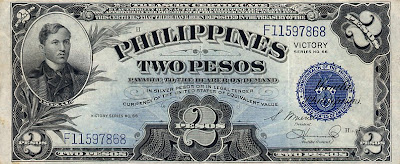
 Five Hundred Piso Banknote
New Design Series
Five Hundred Piso Banknote
New Design Series
Obverse: Benigno S. "Ninoy" Aquino, Jr., Philippine flag, Central Bank seal, dove of peace, Ninoy's typewriter with his initials ("B.S.A.J."), "Faith in our people and faith in God", "The Filipino is worth dying for"
Reverse: scenes from Ninoy Aquino's life and some allegorical groups (see note below)
Predominant color: yellow
Security thread: 0.75 mm embedded magnetic and metallic; for newer notes, 1.4 mm windowed colorshift (magenta-green) with cleartext “500”
Length: 160mm
Width: 66mm
Thickness: 100-118 microns
Material: 20% abaca, 80% cotton
Security Features: security thread, red & blue visible fibers,
fluorescent printing, iridescent band, windowed security thread,
concealed numerical value, and
micro-printing
Text: "Republika ng Pilipinas", "Limandaang Piso", "Ang salaping ito ay bayarin ng Bangko Sentral at pananagutan ng Republika ng Pilipinas"
The reverse side features a collage of various images in relation to Aquino. He was (out of some of the pictures) a journalist for the Manila Times, a senator (the pioneer of the Study Now, Pay Later education program), the mayor in his hometown of Concepcion, the governor of Tarlac, and was the main driving force behind the People Power Revolution of 1986, some three years after his death in 1983.
It is also interesting to note that unlike the names of the figures on the bills, "Benigno S. Aquino, Jr." is written in gold-coloured, cursive writing with a green laurel wreath as opposed to the name being simply written as with the other banknotes.
Before this note was printed,
500-piso banknote was to have Ferdinand Marcos and its back was the Batasang Pambansa Complex until People Power Revolution when it was replaced by the current 500-piso banknote. Remnants of this version of the banknote are only for media purposes.
Related post: Cory to Join Ninoy on P500 bill?



























